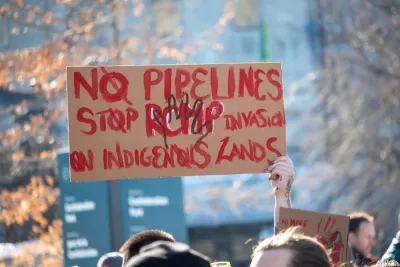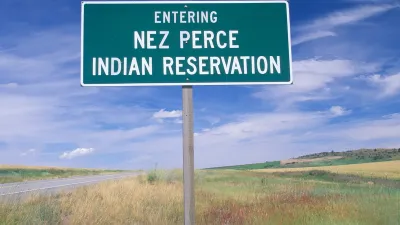A 500-year struggle has gained momentum in the days of social media.

An article by B. Toastie for High Country News explains the Land Back movement, which has been gaining prominence as the internet spreads the words. The Land Back movement, as the name clearly implies, goes beyond land acknowledgement, which has also gained mainstream traction in recent years.
There’s a simple explanation for the demands of the movement. To explain, the article poses the question: “What is the LandBack movement really asking for?” The answer is simple: “The land. Back.”
The movement won a major Land Back victory of the return of Blue Lake back to the Taos Pueblo in 1970, but a social media hashtag has raised awareness of the movement more into the mainstream. “In mid-2019, the hashtag gained traction in North America during the Tiny House Warriors’ blockade of the Trans Mountain Pipeline in unceded Secwepemc territory,” writes Toastie. “Soon after, the Yellowhead Institute, an Indigenous-led policy research center at Toronto Metropolitan University, released a report called Land Back that examined settler-colonialism at work in present-day Canada. In August 2020, the advocacy group NDN Collective launched landback.org with a brief LandBack Manifesto, followed by a campaign launch on Indigenous Peoples Day.”
According to the article, the appointment of Deb Haaland (Laguna Pueblo) as secretary of the Interior, and of Chuck Sams (Umatilla) as director of the National Park Service, the first Native people to hold either office is also furthering the cause.
The source article includes a lot more discussion and explanation.
FULL STORY: Questions about the LandBack movement, answered

Montreal Mall to Become 6,000 Housing Units
Place Versailles will be transformed into a mixed-use complex over the next 25 years.

Planetizen Federal Action Tracker
A weekly monitor of how Trump’s orders and actions are impacting planners and planning in America.

DARTSpace Platform Streamlines Dallas TOD Application Process
The Dallas transit agency hopes a shorter permitting timeline will boost transit-oriented development around rail stations.

Without International Immigrants, the Rural US Population Would Be Falling 58%
Census data shows that population growth in rural areas is due in large part to international migrants.

Dead End: Nine Highways Ready for Retirement
The Freeways Without Futures report describes the nation’s most promising highway removal proposals.

Congressman Proposes Bill to Rename DC Metro “Trump Train”
The Make Autorail Great Again Act would withhold federal funding to the system until the Washington Metropolitan Area Transit Authority (WMATA), rebrands as the Washington Metropolitan Authority for Greater Access (WMAGA).
Urban Design for Planners 1: Software Tools
This six-course series explores essential urban design concepts using open source software and equips planners with the tools they need to participate fully in the urban design process.
Planning for Universal Design
Learn the tools for implementing Universal Design in planning regulations.
City of Mt Shasta
City of Camden Redevelopment Agency
City of Astoria
Transportation Research & Education Center (TREC) at Portland State University
City of Camden Redevelopment Agency
Municipality of Princeton (NJ)
Regional Transportation Commission of Southern Nevada





























